House Finch vs. House Sparrow: The Main Differences
Last Updated on
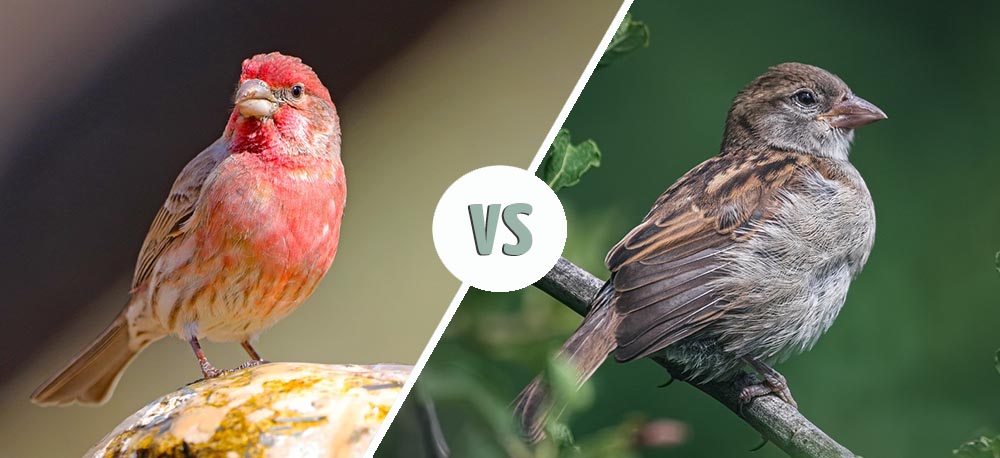
House Finches and House Sparrows are commonly sighted birds in North America. You’d see them in your backyard, perched on the bird feeders, or flitting about in the trees.
Both species are adaptable and thrive well in environments with different kinds of human disturbances. There’s some symbolism around House Finches too.
Many say they’re a sign for you to follow your joy. Since House Finches flutter about and don’t stay in one place for long, they’re also a reminder that life is ever-changing and to enjoy the moment. Likewise, House Sparrows are familiar visitors in most homes, delighting humans with their chirpy chatter.
But while they may look similar, there are some key differences between these two bird species. Here’s an overview of their differences.

At a Glance

House Finches and House Sparrows are small birds that may appear similar. But they have different sizes and origins.
- Origin: Native to Western US and Mexico
- Size: 13–14 cm
- Lifespan: 11 years
- Domesticated?: No
- Origin: Native to Europe, Asia, and North Africa
- Size: 14–18 cm
- Lifespan: 3 years
- Domesticated?: No
House Finch Overview
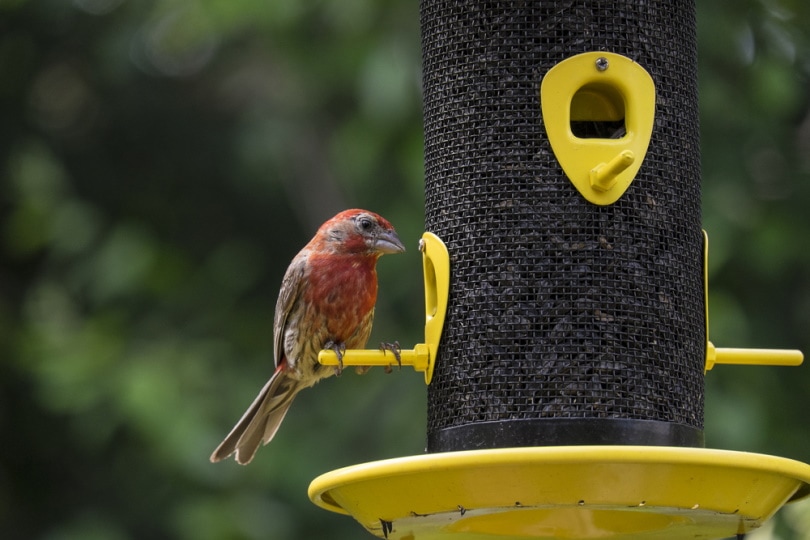
House Finches are small finches with flat heads and large beaks. Since they have short wings, their tail seems long compared to the rest of the body. In addition, while most other finches have notched tails, the notch on a House Finch’s tail is relatively shallow.
Characteristics & Appearance
Adult House Finches have a canonical bill, shaped appropriately to eat seeds. Their tails are notches, whereas their belly, tail, and back have brown streaks. Meanwhile, they are red around their upper breasts and faces.
Meanwhile, the female finches look similar to their male counterparts, except that they do not have red around their faces. Instead, they have grayish-brown bodies with thick streaks across their face.
House Finches can often look different from each other, especially if they eat different diets. However, the regional differences don’t contribute to the difference in the appearance of House Finches. The finches from Long Island will be broadly similar to those across the West unless they have different dietary habits.
Finches that eat more carotenoid-containing seeds have redder appearances. Females also tend to mate more with redder mates.
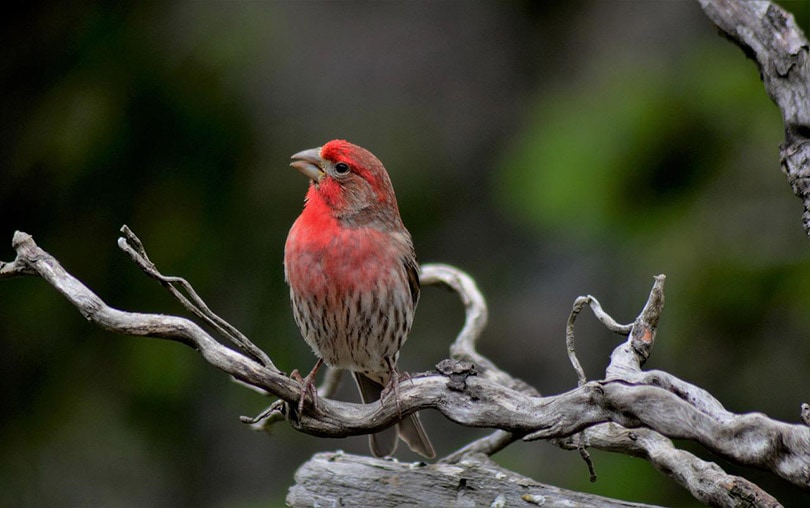
Behavior & Habitat
House Finches are social creatures that often travel in pairs or small groups. They are also monogamous and will mate for life. During the day, they can be seen perching on trees or power lines. Meanwhile, at night they roost in small groups in trees.
Their diet consists mainly of seeds, and they feed in different places. If you don’t see them in the bird feeder, they’ll probably be on the ground, feeding on weed stalks.
They crush seeds with their canonical bills and take quick bites. Like other finch species, House Finches also have a bouncy flight.
Besides backyards, House Finches are also seen in urban centers, forest edges, farms, and city parks. In the Western regions of the US, they are also present in grasslands, open woods, deserts, and chaparral.

House Sparrow Overview

The House Sparrow is a small bird with a stout build and a relatively short neck and tail. The bill is black with a bare patch of flesh around the base, and the legs are pinkish.
House Sparrows were introduced to the US in 1851 when released in Brooklyn, New York. In the next few decades, the birds spread all the way to the Rocky Mountains. Finally, in the 1870s, House Sparrows were introduced into Salt Lake City and San Francisco, increasing their presence in the West.
Today, you can find them across North America and Canada. They’re only absent in Alaska. Unlike other birds that prefer to nest in tree holes and natural sites, House Sparrows make their nests in human-made structures, like walls, nest boxes, and streetlights.
Characteristics & Appearance
Male House Sparrows have stout bills and round heads. If they’re breeding, their crows will be gray and cheeks white. They also sport a black bib in the chestnut neck region.
Female House Sparrows also have a stout bill. While they are generally gray-brown, their backs are striped with brown, black, and buff colors.
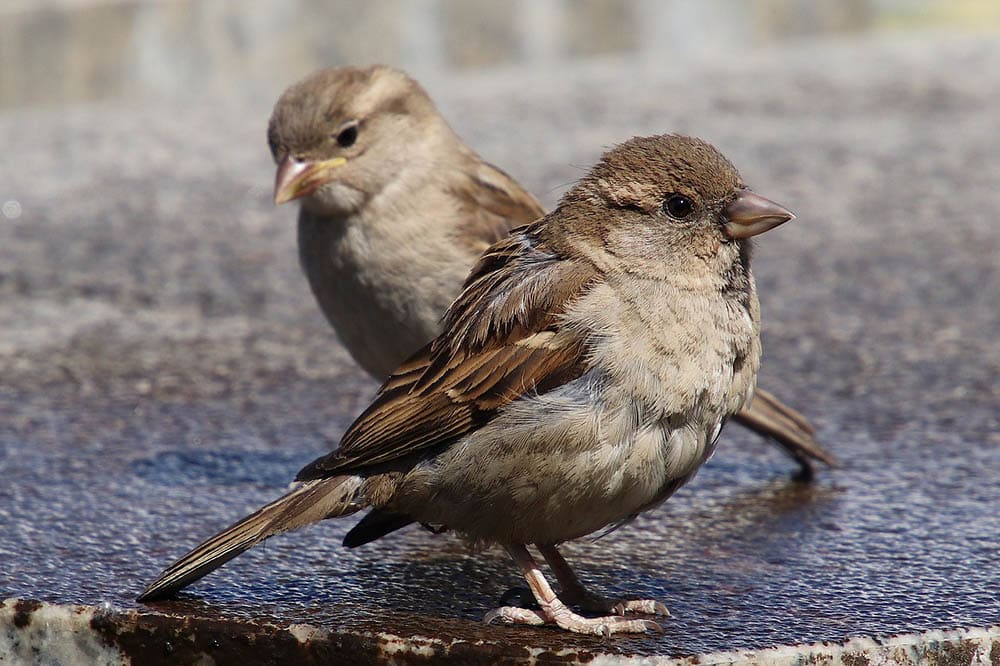
Behavior & Habitat
House Sparrows are known for being noisy and aggressive. They will chase away other birds that come too close to their nests.
House Sparrows are social creatures and often build their nests next to each other. A single nest can house up to many birds.
Since humans and House Sparrows have existed together for centuries, you’ll find these birds in almost every habitat. They’re comfortable around humans and will even make their nests close to people.
House Sparrows are seed eaters, but they will also feast on insects, berries, and fruits. You can attract them to your backyard by keeping a bird feeder stocked with seeds.
You won’t find House Sparrows in grasslands and undisturbed forests. However, they’re a common sight around farmsteads and parking lots, where they search for insects on car grills.
What Are the Differences Between House Finches and House Sparrows?
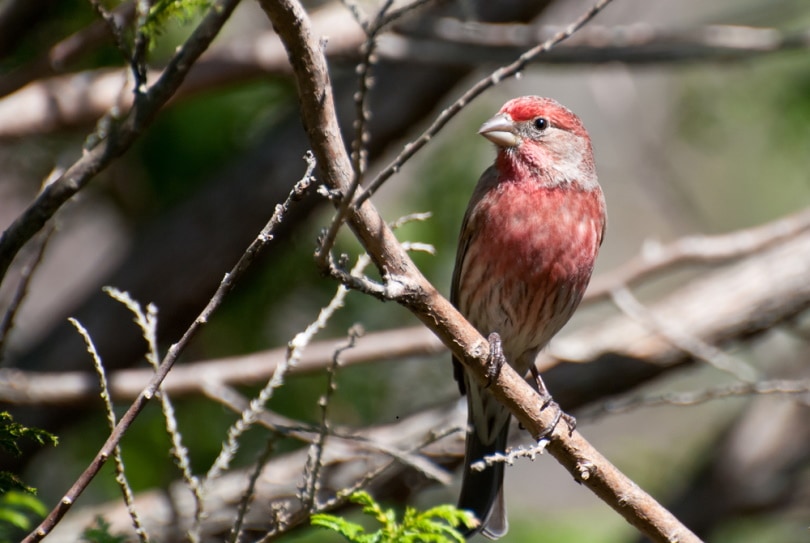
There are several differences between House Finches and House Sparrows. One of the most noticeable is size, as sparrows can appear smaller due to the absence of the long tail that finches sport. However, sparrows have longer legs than sparrows that are pinkish.
Meanwhile, finches have dark gray legs. Finches also typically have red coloring on their heads, while sparrows tend to be browner. Sparrows also have intricate patterns on their bodies that finches lack.
The two birds also have different songs. Sparrows usually sing a monotonous “chirp,” while finches have a more varied repertoire. Sparrows also build their nests differently, as they like to live in human-made structures.
Finches typically use twigs and leaves to build their nests. Apart from that, both birds are known to be very adaptable and can live in a variety of environments. They are also both seed eaters but will also consume insects.

Which Bird Do You Prefer?
Both House Finches and House Sparrows are delightful birds to welcome in your backyards. While sparrows might be a bit noisier, listening to their chatter early in the morning can be charming.
Likewise, the red of male finches adds a splash of color to any yard, and their melodious singing is a joy to listen to. If you want to attract both birds, you should provide food and shelter for each type.
House Finches prefer black oil sunflower seeds. So, make sure your bird feeder is stocked on sunflower seeds for these tiny beauties. Meanwhile, House Sparrows like milo, sunflower, and millet seeds. You can also put up a nest box if you want a sparrow to build their home in your backyard.
Featured Image Credit: (L) George, Pixabay | (R) SAM_MINO, Pixabay
About the Author Jeff Weishaupt
Jeff is a tech professional by day, writer, and amateur photographer by night. He's had the privilege of leading software teams for startups to the Fortune 100 over the past two decades. He currently works in the data privacy space. Jeff's amateur photography interests started in 2008 when he got his first DSLR camera, the Canon Rebel. Since then, he's taken tens of thousands of photos. His favorite handheld camera these days is his Google Pixel 6 XL. He loves taking photos of nature and his kids. In 2016, he bought his first drone, the Mavic Pro. Taking photos from the air is an amazing perspective, and he loves to take his drone while traveling.
Related Articles:
10 Types of Hummingbirds in Arkansas (With Pictures)
8 Types of Hummingbirds in Nebraska (With Pictures)
5 Types of Hummingbirds in Idaho (With Pictures)
3 Types of Hummingbirds in Mississippi (With Pictures)
8 Types of Hummingbirds in Kansas (With Pictures)
5 Types of Hummingbirds in West Virginia (With Pictures)
5 Types of Hummingbirds in Ohio (With Pictures)
Where Do Nuthatches Nest? Nuthatch Nesting Habits Explained
